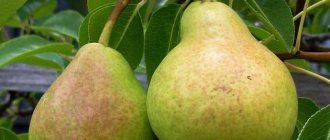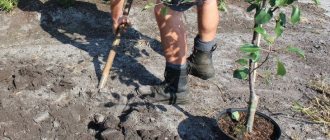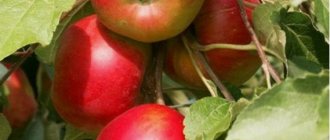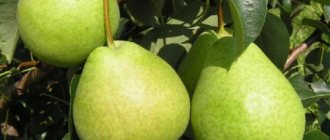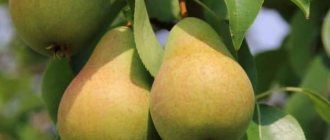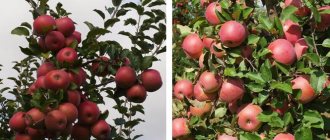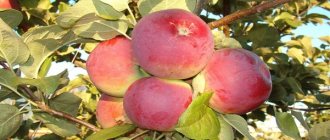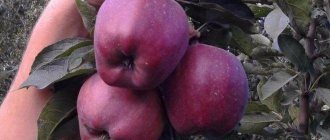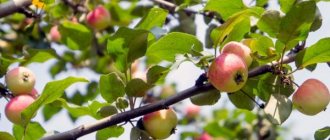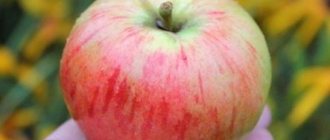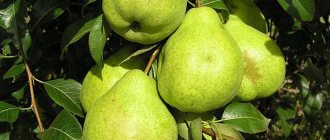Pear Decor.
Description of the variety
The columnar Decora pear is a late-summer ripening variety. The variety has good frost resistance and is widely distributed in gardens in the Moscow region.
Characteristics of wood
Trees of this variety are low-growing and their height does not exceed 2 meters. The crown is vertical, narrow, and prone to thickening. The lateral branches are weakly expressed and grow at an acute angle relative to the trunk. The leaves are medium in size, oval. The surface of the leaf plate is smooth.
Description of fruits
Decor.
Pears are large and can weigh about 200-300 grams. The shape of the fruit is pear-shaped, standard, without pronounced ribbing. Ripe fruits are evenly colored in a beautiful yellow hue. There is no blush. The taste is very pleasant, delicate, sweet, with a pronounced aroma.
The harvest begins to ripen in the second half of August. Fruits should be collected in several stages as they ripen to prevent shedding. If suitable conditions are provided, the fruits are stored well.
Characteristics of the Decora columnar pear variety
The tree successfully takes root and bears fruit in central Russia and the southern regions. If you adhere to the rules of agricultural technology, the harvest will also ripen in countries with a northern climate.
Drought resistance, frost resistance
Despite the resistance of the Decor pear to unfavorable conditions, the tree needs shelter in winter. The variety tolerates temperature drops down to -20 °C. In the Northern regions, it is preferable to cover the Decorah pear or grow it in large pots so that it is possible to transfer the crop indoors.
Pollinators
The Decorah pear is self-fertile and therefore does not require pollinators. To increase productivity, it is possible to plant certain types of trees nearby:
- Chizhevsky pear: tree height varies from 1.8 to 2.5 m. The seedlings have a narrow crown, which forms into a cone after the start of fruiting. The first harvest ripens 3-4 years after planting.
- Lada pear: a tree with a pyramidal, medium-dense crown, reaches a height of 5 m. The variety is winter-hardy, the first harvest is possible 2-4 years after planting.
- Yakovlev Memory Pear: a fast-growing tree, does not exceed 1.5-2 m in height. The crown of the crop is rounded, medium-thick. The first harvest is harvested 7 years after planting the tree.
All pollinating varieties should be located at a distance of 4-5 m from each other. If the seedlings are located closer together, the vital activity of one of them may be suppressed.
Productivity
According to the description and photo, the columnar Decora pear begins to form an ovary early: 2-3 years after being transferred to open ground. Ripe fruits can be collected annually, since there is no cyclicity.
The tree can bear up to 20 kg, if you do not neglect the rules of agricultural technology. The first inflorescences may appear in the first summer after transfer to open ground, but it is recommended to remove them. Every year the number of ovaries must be adjusted based on the condition of the tree.
The close location (2-3 m from the seedling) of tall trees and non-compliance with the rules of agricultural technology have a negative effect on the yield.
To ensure maximum shelf life, it is necessary to follow the rules for collecting and storing fruits:
- Only fruits that have begun to ripen, along with the stem, should be picked from the tree. Decora pears of medium ripeness are not suitable for transportation and sale. Fully ripened fruits should be eaten within a short period of time.
- Harvesting takes place in dry and clear weather.
- Whole fruits must be placed separately from damaged pears.
- For long-term storage, it is necessary to transfer the collected fruits to the basement, where they are placed in a separate container made of wood. Every 20 days, Decor pears must be inspected for integrity.
Important! The optimal temperature for maintaining the integrity of the fruit is + 1-3 °C. Humidity in the room should not exceed 85%.
Application area
The use of Decor pear fruits is very diverse: the fruit is suitable for preparing various dishes and canning. A ripe harvest is not suitable for long-term transportation and storage.
Advantages and disadvantages
The variety is common among gardeners who own small plots. The decorative pear has a number of advantages:
- columnar shape of the tree and compact dimensions;
- self-fertility;
- good yield indicators;
- large size of the fruit, good keeping quality of the fruit if harvested and stored correctly;
- precociousness;
- frost resistance.
The disadvantages of the Decorah pear include poor preservation of ripe fruits. If they are not collected in time, they quickly fall off and deteriorate.
Reviews
The pear is just great. It was planted on the plot near the house mainly for beauty, but it bears such tasty fruits that its decorativeness has faded into the background. Plus, the pears look very appetizing.
Konstantin
Naro-Fominsk
The trees are very beautiful, especially in the spring during the flowering period. And the most important thing is that this beauty also brings a good harvest. If in the spring the tree is covered with beautiful white flowers, then in the fall there are no less beautiful yellow pears.
Tatiana
Serpukhov
These are the most delicious of all columnar varieties, and I have several types growing. You can collect a few buckets from a small tree, enough to eat. The tree itself grows on a plot of meter by meter.
Vitaly
Moscow region
Advantages and disadvantages of the variety
The columnar Sapphire variety has the following advantages compared to conventional pear varieties:
- compact dimensions;
- early entry into fruiting (in the 2nd year);
- annual fruiting and high yield, reaching 80 kg from one mature tree;
- resistance to scab and other diseases caused by microscopic fungi;
- large fruits - with good care you can get 300 g pears;
- the fruits are stored until December;
- high decorative qualities.
Compared to other columnar varieties, Sapphira stands out noticeably:
- beautiful red-violet or burgundy fruits;
- sweet taste;
- good storage of fruits harvested at technical maturity;
The disadvantages of the variety include:
- fragility of trees, after 10 years of age they grow old and produce little yield;
- low productivity on infertile soils;
- with heavy pruning, the tree tends to thicken with small shoots;
- superficial root system.
Landing
Decorah pear loves sunlight and adapts well to different types of soil. Detailed instructions for selecting and preparing a seat can be found by clicking on the links below.
How to plant a pear tree correctly
At what distance to plant pears?
How to choose pear seedlings
How to replant a pear
How and when boarding takes place
In terms of time, it is better to choose not autumn, but spring. The root system of this species is located quite close to the surface of the earth, so planting in winter is risky - the plant must get stronger and take root. And, as usual in gardening, it is advisable to prepare the holes in advance. This is done as follows:
- The distance between them should be at least 50 cm, and between the rows - at least 100 cm. If you leave a very small area for seedlings, insufficient light and air will reach it, and there is also a high probability of parasites appearing.
- In the hole, at the bottom, you need to pour a mixture of compost, soil and humus, and pour a bucket of water on top.
Now about the landing process:
- After all the moisture has been absorbed, a seedling is placed in the hole. The roots are straightened out in all directions, and a stake is driven somewhere between them.
- First, the earth is poured out so that only half of the hole is filled with it. It is compacted well, then the rest of the soil is poured in and compacted again.
- When the tree is planted, you need to carefully water it. This is done gradually so that the moisture is immediately absorbed.
- If the ground settles, add more.
- Lastly, the seedling is tied to a previously installed peg.
Care
The variety is generally unpretentious, but requires regular pruning, as the tree is prone to thickening of the crown. More information and recommendations for growing this variety can be found in the articles selected below.
How to care for a pear Pruning a pear Pruning a columnar pear Treating a pear from diseases and pests Feeding a pear How to water a pear
PEAR COLUMNS AND Dwarfs
Columnar apple trees are increasingly being advertised in planting material markets. In the colorful pictures, the trees are like sticks, small in stature, densely covered with large, beautiful fruits; the impressive stories of the sellers are so convincing that crowds of buyers are purchasing the not-cheap “supernova” varieties of columnar apple trees.
The most interesting thing is that they also offer columnar pears, which simply do not exist in nature. Online stores and advertising in various print publications are literally full of elegant pictures depicting a “miracle stick” hung with elegant pear fruits. Looking at such photos and succumbing to the seller’s fabulous stories, people quickly snap up imaginary new items.
What's the result? Or the “miracle tree” turns out to be the most ordinary one, and under the guise of a wonderful “column” they sold you a long-known tall variety - perhaps not even intended for cultivation in your region.
Diseases and pests
The tree has good resistance to many diseases and insect attacks. However, if agricultural technology is performed incorrectly or the pear is exposed to unfavorable external factors, it can be affected by various ailments.
Materials on the topic of protection and prevention of Decorah pears can be found by clicking on the links below.
Dangerous Pear Pests
Pears often suffer from pests, they affect the leaves, bark and fruits.
In this article, we have selected 11 of the most harmful insects that harm pear trees, and also ways to destroy them.
Diseases of pear trees
To get what they cherish, gardeners have to work hard, and the reason for this is pear diseases.
Read about 19 common pear diseases and how to combat them.
conclusions
- Decora pear is described as a tasty columnar variety with a compact crown. The fruits can be picked fully ripe or green - starting in August and throughout the fall.
- When planting a garden, use only one- and two-year-olds. Older planting material does not take root well.
- Fertilizing is done root and foliar. Apply fertilizers according to the calendar; after rejuvenation, feeding is suspended.
- In the first year after planting, the trees are not pruned; in the second year, small shaping is needed.
- The presence of pollinating plants is not required for Decoration.
Find out what to plant next to a pear at this link.
